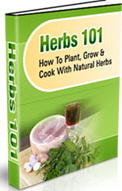Tarragon (French)
 Tarragon has been a popular herb in classic French cooking for years. Given the right conditions in a home garden or pot, an average gardener can grow and enjoy this flavorful herb. There are two common types of Tarragon, French and Russian, with French being far superior and recommended as a culinary herb.
Tarragon has been a popular herb in classic French cooking for years. Given the right conditions in a home garden or pot, an average gardener can grow and enjoy this flavorful herb. There are two common types of Tarragon, French and Russian, with French being far superior and recommended as a culinary herb.
Tarragon is a perennial herb that grows to 2 to 4 feet. The leaves are grayish green in color and are 2 to 3 inches in width. The Tarragon plant produces small yellow flowers on bloom.
The health benefits of Tarragon include Vitamin A, thiamine, riboflavin, niacin, calcium, and potassium.
Growing Tarragon
Tarragon may be grown in either containers or in a garden. If grown indoors, Tarragon should be planted in 8 to 10 inch diameter pots. Most gardeners purchase a plant that is already started instead of growing from seeds. The seeds of the French Tarragon plant are traditionally difficult to germinate. It is recommended to either cultivate by root division or purchase French Tarragon as a nursery plant. Take care when purchasing French Tarragon to make sure it’s true French tarragon and not Russian Tarragon. Russian Tarragon is a heartier plant but not recommended for culinary purposes.
It is recommended to plant Tarragon in full sun for the best growing conditions. If you are growing indoors, the pant should receive 5 to 6 hours of direct sunlight per day. The soil for the plant should be well draining, and the plant itself should not be over watered. Tarragon is susceptible to root rot with overwatering.
Tarragon plants may be moved indoors for the winter, but should be exposed to some cold weather before attempting to bring them indoors.
Harvesting Tarragon:
Tarragon may be harvested by removing a third of each branch. The best time to harvest the plant is in July or August of the second year of growth. Damaged or brownish leaves should be discarded. Once the branch is removed, wash each branch and snip off the leaves. The prepared leaves can be placed in a sealed plastic bag and frozen for future use.
For French tarragon recipes click here.

